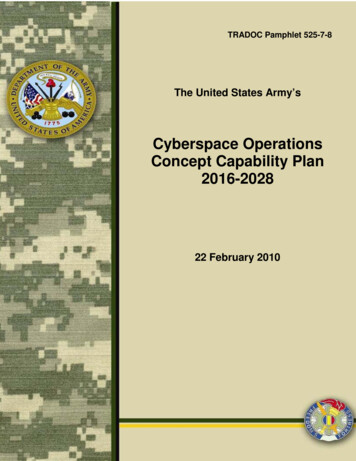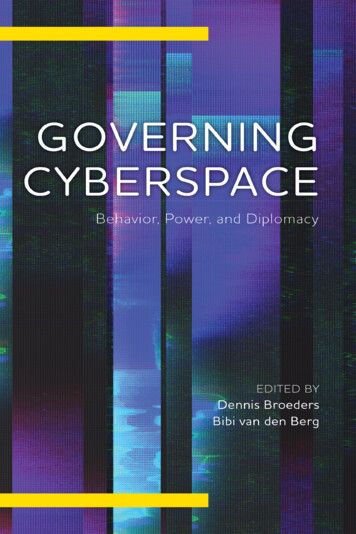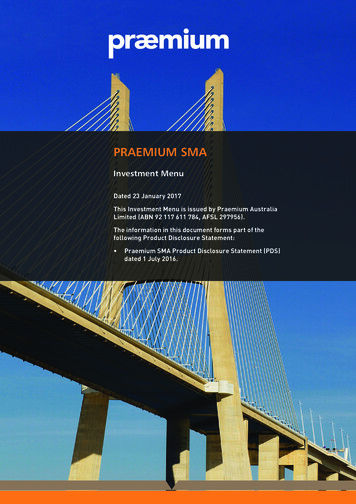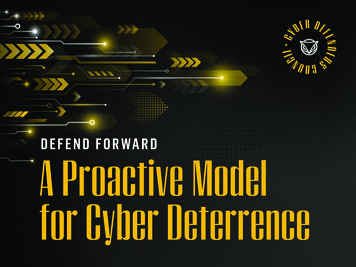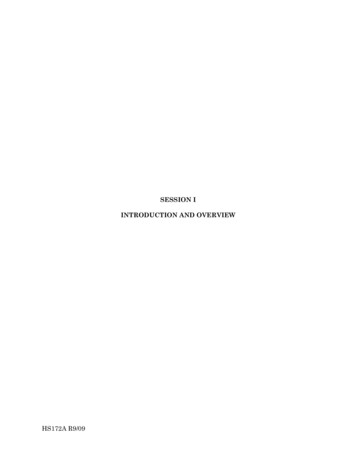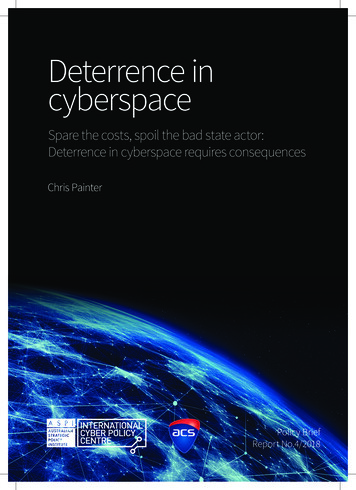
Transcription
Deterrence incyberspaceSpare the costs, spoil the bad state actor:Deterrence in cyberspace requires consequencesChris PainterPolicy BriefReport No.4/2018
About the authorChris Painter is a distinguished non-resident fellow at ASPI’s International Cyber Policy Centre. He is a globally recognized leader and anexpert on cybersecurity, cyber policy, cyber diplomacy and combatting cybercrime. He has been on the vanguard of US and internationalcyber issues for over twenty-five years—first as a leading federal prosecutor of some of the most high-profile cybercrime cases in thecountry, then as a senior official at the Department of Justice, the FBI, the National Security Council and finally as the world’s first topcyber diplomat at the State Department. He has helped drive, initiated or been involved in virtually every major US cyber policy for overa decade and has created innovative new organizations and approaches to deal with threats and take advantage of opportunities incyberspace. Among other things, he currently serves as a Commissioner on the Global Commission for the Stability of Cyberspace and is amember of the Board of Directors for the Center for Internet Security.What is ASPI?The Australian Strategic Policy Institute (ASPI) was formed in 2001 as an independent, non‑partisan think tank. Its core aim is to providethe Australian Government with fresh ideas on Australia’s defence, security and strategic policy choices. ASPI is responsible for informingthe public on a range of strategic issues, generating new thinking for government and harnessing strategic thinking internationally.ASPI International Cyber Policy CentreThe ASPI International Cyber Policy Centre’s mission is to shape debate, policy and understanding on cyber issues, informed by originalresearch and close consultation with government, business and civil society.It seeks to improve debate, policy and understanding on cyber issues by:1. conducting applied, original empirical research2. linking government, business and civil society3. leading debates and influencing policy in Australia and the Asia–Pacific.We thank all of those who contribute to the ICPC with their time, intellect and passion for the subject matter. The work of the ICPC wouldbe impossible without the financial support of our various sponsors but special mention in this case should go to the Australian ComputerSociety (ACS), which has supported this research.Chris Painter’s distinguished visiting fellowship at ASPI’s International Cyber Policy Centre was made possible through the generoussupport of DFAT through its Special Visits Program. All views expressed in this policy brief are the authors.Important disclaimerThis publication is designed to provide accurate and authoritative information in relation to the subject matter covered. It is provided withthe understanding that the publisher is not engaged in rendering any form of professional or other advice or services. No person shouldrely on the contents of this publication without first obtaining advice from a qualified professional person.ASPITel 61 2 6270 5100Fax 61 2 6273 9566Email gist.org.aufacebook.com/ASPI.org@ASPI ICPCwww.aspi.org.au/icpc/home The Australian Strategic Policy Institute Limited 2018This publication is subject to copyright. Except as permitted under the Copyright Act 1968, no part of it may in any form or by any means(electronic, mechanical, microcopying, photocopying, recording or otherwise) be reproduced, stored in a retrieval system or transmittedwithout prior written permission. Enquiries should be addressed to the publishers.First published June 2018.Cover image: Global international connectivity graphic spainter vfx/iStock.
Deterrence incyberspaceSpare the costs, spoil the bad state actor:Deterrence in cyberspace requires consequencesChris PainterPolicy BriefReport No.4/2018
ContentsForeword 03What’s the problem? 04What’s the solution? 05The challenge of attribution 05Naming and shaming 06General considerations 06Collective action 07Using and expanding the tools in the toolkit 07Recommendations 0902Policy Brief: Deterrence in cyberspace
ForewordIn the past three years, barely a week has gone by without a report of a criticalcyberattack on a business or government institution. We are constantlybombarded by revelations of new ransomware strains, new botnets executingdenial of service attacks, and the rapidly expanding use of social media as adisinformation and propaganda platform.Perhaps most alarmingly, a great many of these attacks have their origin in thegovernments of nation states.In the past decade we have moved well beyond business as usual signals intelligence operations.Some of the largest malware outbreaks in recent years, such as NotPetya and WannaCry, hadtheir origins in state-run skunkworks.Cyberattacks initiated by nation states have become the new normal, and countries includingAustralia have struggled with the challenge of how to respond to them. Far too often they’reconsidered a low priority and met with a shrug of the shoulders and a “What can you do?”In this paper, Chris Painter offers us a way forward. Chris presents a reasonable framework fordeterrence, a way that we as a nation can help limit the deployment of cyberwarfare tools.His recommendations are designed to properly punish bad actors in a way that discouragesfuture bad behaviour. They’re modelled on actions that have worked in the past, and serve, ifnot as a final solution, at least as a starting point for us to scale back on the increasing number ofstate-sponsored cyber attacks.Most importantly, these actions aren’t just to the benefit of the state—they will allow us to betterprotect private citizens and companies that all too often get caught in the cyberwarfare crossfire.To put it simply, if we can ensure there are costs and consequences for those who wrongly usethese tools to wreak damage, bad actors might start thinking twice before engaging in thisdestructive behaviour.Yohan RamasundaraPresident, Australian Computer Society03
What’s the problem?Over the past few years, there’s been a substantial increase in state attacks on, and intrusionsinto, critical information systems around the globe—some causing widespread financial and otherdamage.1 They have included: attacks by North Korea on Sony Pictures in 2014 widespread Chinese theft of trade secrets and intellectual property Russian state-sponsored interference in the US elections North Korea’s sponsorship of the WannaCry ransomware worm that caused, among otherthings, a meltdown of the UK’s National Health System the Russian-sponsored NotPetya worm that caused tens of millions of dollars of damage anddisruption around the world.The pace and severity of these attacks show no sign of declining. Indeed, because there haveusually been little or no consequences or costs imposed on the states that have taken theseactions, they and others have little reason not to engage in such acts in the future.The US, Australia and many other countries have spent years advancing a framework for globalstability in cyberspace. This framework comprises: the application of international law to cyberspace acceptance of certain voluntary norms of state behaviour in cyberspace (essentially, voluntaryrules of the road) the adoption of confidence and transparency building measures.Although much progress has been achieved in advancing this framework, the tenets ofinternational law and norms of state behaviour mean little if there are no consequences for thosestates that violate them. This is as true in the cyber world as in the physical one. Inaction createsits own norm, or at least an expectation on the part of bad state actors that their activity isacceptable because there are no costs for their actions and no likely costs for future bad acts.Individually as countries and as a global community, we haven’t done a very effective job ofpunishing and thereby deterring bad state actors in cyberspace. Part of an effective deterrencestrategy is a timely and a credible response that has the effect of changing the behaviour of anadversary who commits unacceptable actions. Although there are some recent signs of change,in the vast majority of cases the response to malicious state actions has been neither timely norparticularly effective. This serves only to embolden bad actors, not deter them. We must do betterif we’re to achieve a more stable and safe cyber environment.04Policy Brief: Deterrence in cyberspace
What’s the solution?It is a well-worn and almost axiomatic expression that deterrence is hard in cyberspace.Some even assert that deterrence in this realm is impossible. Although I don’t agree with thatfatalistic outlook, it’s true that deterrence in cyberspace is a complex issue. Among other things,an effective deterrence framework involves strengthening defences (deterrence by denial);building and expanding the consensus for expectations of appropriate state behaviour incyberspace (norms and the application of international law); crafting and communicating—topotential adversaries, like-minded partners and the public—a strong declaratory policy; timelyconsequences, or the credible threat thereof, for transgressors; and building partnerships toenable flexible collective action against those transgressors. Although I’ll touch on a couple ofthose issues, I’ll focus here on imposing timely and credible consequences.The challenge of attributionOne of the most widely cited reasons for the lack of action is the actual and perceived difficultyin attributing malicious cyber activity. Unlike in the physical world, there are no launch plumesto give warning of the location of the origin of a cyberattack, and sophisticated nation-statesare adept at hiding their digital trail by using proxies and routing their attacks through ofteninnocent third parties. But, as recent events illustrate, attribution, though a challenge, is notimpossible. Moreover, attribution involves more than following the digital footprints; other formsof intelligence, motive and other factors all contribute to attribution. And, ultimately, attribution ofstate conduct is a political decision. There’s no accepted standard for when a state may attributea cyberattack, although, as a practical, political and prudential matter, they’re unlikely to do sounless they have a relatively high degree of confidence. Importantly, this is also true of physicalworld attacks. Certainly, a state doesn’t require 100% certainty before attribution can be madeor action taken (as some states have suggested). Whether in the physical or the cyber world, sucha standard would practically result in attribution never being made and response actions neverbeing taken.Although attribution is often achievable, even if difficult, it still seems to take far too long—at leastfor public announcements of state attribution. Announcing blame, even if coupled with someresponsive actions, six months to a year after the event isn’t particularly timely. Often by that pointthe impact of the original event has faded from public consciousness and so, too, has the will toimpose consequences. Part of this delay is likely to be due to technical difficulties in gathering andassembling the requisite evidence and the natural desire to be on solid ground; part is likely tobe due to balancing public attribution against the possible compromise of sources and methodsused to observe or detect future malicious activity; but part of it’s probably due to the need tosummon the political will to announce blame and take action—particularly when more than onecountry is joining in the attribution. All of these cycles need to be shortened.05
Naming and shamingPublic attribution of state conduct is one tool of deterrence and also helps legitimise concurrentor later responses. The US, the UK, Australia and other countries came together recently toattribute the damaging NotPetya worm to Russia and, a few months ago, publicly attributedthe WannaCry ransomware to North Korea. This recent trend to attribute unacceptable stateconduct is a welcome development and should be applauded.2 It helps cut through themyth that attribution is impossible and that bad state actors can hide behind the internet’sseeming anonymity.However, public attribution has its limits. Naming and shaming has little effect on states thatdon’t care if they’re publicly outed and has the opposite effect if the actor thinks their power isenhanced by having actions attributed to them. In the above two cases, it’s doubtful that namingand shaming alone will change either North Korea’s or Russia’s conduct. Public attribution inthese cases, however, still serves as a valuable first step to taking further action. Indeed, in bothcases, further actions were promised when public attribution was made. That raises a couple ofissues. First, those actions need to happen and they need to be effective. President Obama statedafter the public attribution to North Korea in relation to the Sony Pictures attack that some ofthe response actions ‘would be seen and others unseen’. A fair point, but at least some need tobe seen to reinforce a deterrent message with the adversary, other potential adversaries and thepublic at large. The other issue is timing. The public attribution of both WannaCry and NotPetyacame six months after the respective attacks. That delay may well have been necessary either fortechnical reasons or because of the work required to build a coalition of countries to announcethe same conclusion, but attribution that long after the cyber event should be coupled withdeclared consequences—not just the promise that they’re to come. Some action did in fact comein the NotPetya case about a month after public attribution, when the US sanctioned severalRussian actors for election interference, NotPetya and other matters. That was a very good startbut would be even more effective in the future if done when the public attribution occurs. Actionspeaks louder than attribution alone, and they must be closely coupled to be effective.General considerationsA few general considerations apply to any contemplated response action to a cyber event. First,when measures are taken against bad actors, they can’t just be symbolic but must have thepotential to change that actor’s behaviour. That means that one size does not fit all. Differentregimes hold different things dear and will respond only if something they prioritise or care aboutis affected. Tailored deterrence strategies are therefore required for different states.3 For example,many have opined that Russia is more likely to respond if sanctions are targeted at Putin’sfinancial infrastructure and that of his close elites than if simply levied in a more general way.Second, the best response to a cyberattack is seldom a cyber response. Developing cybertoolsand having those tools as one arrow in the quiver is important, but other responses will often bemore effective. Third, the response to a cyber event shouldn’t be approached in a cyber silo but06Policy Brief: Deterrence in cyberspace
take into account and leverage the overall relationship with the country involved. The agreementthat the US reached with China that neither should use cyber means to steal the trade secrets andintellectual property of the other to benefit its commercial sectors wouldn’t have come about ifwidespread cyber-enabled intellectual property theft was seen only as a cyber issue. Only whenthis problem was seen as a core national and economic security issue, and only when PresidentObama said that the US was willing to bear friction in the overall US–China relationship, wasprogress really possible. Fourth, a responsive action and accompanying messaging needs to beappropriately sustained and not a one-off that can be easily ignored. Fifth, potential escalationneeds to be considered. This is a particularly difficult issue when escalation paths aren’t welldefined for an event that originates in cyberspace, whether the response is a cyber or a physicalone, and the chance of misperception is high. And finally, any response should comport withinternational law.Collective actionCollective action against a bad actor is almost always more effective than a response by just onestate and garners more legitimacy on the world stage. Of course, if the ‘fiery ball of cyber death’is hurtling towards you, every country has the right to act to defend itself, but, if possible, actingtogether, with each country leveraging its capabilities as appropriate, is better. Collective actiondoesn’t require any particular organised group or even the same countries acting together ineach instance. Flexibility is the key here and will lead to swifter results. The recent attribution ofNotPetya by a number of countries is a good example of collective action to a point. It will beinteresting to see, following the US sanctioning of Russia, whether other states join in imposingcollective consequences.One challenge for both collective attribution and collective action is information sharing.Naturally, every state will want to satisfy itself before taking the political step of public attribution,and that’s even more the case if it’s taking further action against another transgressing state.Sharing sensitive attribution information among states with different levels of capability andability to protect that information is a tough issue even in the best of times. But, if collectiveaction is to happen, and happen on anything approaching a quick timeline, enhancing and evenrethinking information sharing among partner countries is foundational.Using and expanding the tools in the toolkitThe current tools that can be used in any instance to impose consequences are diplomatic,economic (including sanctions), law enforcement, cyber responses and kinetic responses. Someof them have been used in the past to varying degrees and with varying levels of effectivenessbut not in a consistent and strategic way. Some, like kinetic responses, are highly unlikely to beused unless a cyber event causes death and physical injury similar to a physical attack. Othersadmittedly take a while to develop and deploy, but we have to have the political willingness to usethem decisively in the appropriate circumstances and in a timely manner. For example, the US has07
had a cyber-specific sanctions order available since April 2015 and, before its recent use againstRussian actors in March, it had only been used once in December 2017 against Russian actors forelection interference. For the threat of sanctions to be taken seriously, they must be used in amore regular and timely manner, and their targets should be chosen to have a real effect on theviolating state’s decision-making.Our standard tools are somewhat limited, so we must also work to creatively expand the toolset so that we can better affect the unique interests of each adversarial state actor (identified ina tailored deterrence strategy), so that they’ll change course or think twice before committingadditional malicious acts in the future. That is likely to need collaboration not just withingovernments but between them and the private sector, academia, civil society and otherstakeholders in order to identify and develop new tools.08Policy Brief: Deterrence in cyberspace
RecommendationsOf course, foundational work on the application of international law and norms of voluntary statebehaviour should continue. That work helps set the expectation of what conduct is permissible.In addition, states should articulate and communicate strong declaratory policies. Declaratorystatements put potential adversaries on notice about what’s unacceptable4 and can containsome detail about potential responses. In addition, a number of other things can aid in creatingan environment where the threat of consequences is credible:1. Shorten the attribution cycle.Making progress on speeding technical attribution will take time, but delays caused by equityreviews, interagency coordination, political willingness, and securing agreement among severalcountries to share in making attribution are all areas that can be streamlined. Often the bestway to streamline these kinds of processes is to simply exercise them by doing more publicattribution while building a stronger political commitment to call bad actors out. The WannaCryand NotPetya public attributions are a great foundation for exercising the process, identifyingimpediments and speeding the process in the future. Even when attribution is done privately,practice can help shorten interagency delays and equity reviews.2. If attribution can’t be made or announced in a fairly brief period, couple anylater public attribution with at least one visible responsive action.Attribution six months or a year after the fact with the vague promise of future consequences willoften ring hollow, particularly given the poor track record of imposing consequences in the past.When attribution can be made quickly, the promise of a future response is understandable, butdelaying the announcement until it can be married with a response may be more effective.3. Mainstream and treat cybersecurity as a core national and economic securityconcern and not a boutique technical issue.If cyberattacks really pose a significant threat, governments need to start thinking of them likethey think of other incidents in the physical world. It is telling that Prime Minister Theresa Maymade public attribution of the Salisbury poisonings in a matter of days and followed up withconsequences shortly thereafter. Her decisive action also helped galvanise an internationalcoalition in a very short time frame. Obviously that was a serious matter that required a speedyresponse, but the speed was also possible because government leaders are more used to dealingwith physical world incidents. They still don’t understand the impact or importance of cyberevents or have established processes to deal with them. Mainstreaming also expands and makesexisting response options more effective. As noted above, a prime reason for the US–China accordon intellectual property theft was the fact that it was considered a core economic and nationalsecurity issue that was worth creating friction in the overall US–China relationship.09
4. Build flexible alliances of like-minded countries to impose costs on bad actors.A foundational element of this is improving information sharing, both in speed and substance, toenable better collective attribution and action. Given classification and trust issues, improvingtactical information sharing is a difficult issue in any domain. However, a first step is to discusswith partners what information is required well in advance of any particular incident and tocreate the right channels to quickly share that information when needed. It may also require are-evaluation of what information must absolutely be classified and restricted and what can beshared through appropriately sensitive channels. If there’s greater joint attribution and action,this practice will presumably also help build mechanisms to share information and build trust andconfidence in the future with a greater number of partners.5. Improve diplomatic messaging to both partners and adversaries.Improved messaging allows for better coordinated action and serves to link consequences to theactions to which they’re meant to respond. Messaging and communication with the bad actorwhile consequences are being imposed can also help with escalation control. Of course, effectivemessaging must be high-level, sustained and consistent if the bad actor is to take it seriously.Sending mixed messages only serves to undercut any responsive actions that are taken.6. Collaborate to expand the toolkit.Work with like-minded states and other stakeholders to expand the toolkit of potentialconsequences that states can use, or threaten to use, to change and deter bad state actors.7. Work out potential adversary-specific deterrence strategies.Actual or threatened responsive actions are effective only if the target of those actionsis something that matters to the state in question, and that target will differ accordingto the particular state involved. Of course, potential responses should be in accord withinternational law.8. Most importantly, use the tools we already have to respond to seriousmalicious cyber activity by states in a timely manner.Imposing consequences for bad action not only addresses whatever the current bad actions maybe but creates a credible threat that those consequences (or others) will be imposed in the future.None of this is easy or will be accomplished overnight, and there are certainly complexities inescalation, proportionality and other difficult issues, but a lot comes down to a willingness toact—and the current situation isn’t sustainable. The recent US imposition of sanctions is a step inthe right direction, but imposing tailored costs when appropriate needs to be part of a practice,not an aberration, and it must be accompanied by high-level messaging that supports rather thanundercuts its use.10Policy Brief: Deterrence in cyberspace
The 2017 US National Security Strategy promises ‘swift and costly consequences’ for those whotarget the US with cyberattacks. Australia’s International Cyber Engagement Strategy statesthat ‘[h]aving established a firm foundation of international law and norms, the internationalcommunity must now ensure there are effective consequences for those who act contrary tothis consensus.’ On the other hand, Admiral Rogers, the head of US Cyber Command and theNational Security Agency, recently told US lawmakers that President Putin has clearly come to theconclusion that there’s ‘little price to pay here’ for Russia’s hacking provocations, and Putin hastherefore concluded that he ‘can continue this activity’.We must change the calculus of those who believe this is a costless enterprise. Imposing effectiveand timely consequences for state-sponsored cyberattacks is a key part of that change.11
Notes1 Of course, there are an ever-increasing number of attacks and intrusions by criminals, including transnational criminalgroups, as well. Deterring this activity is a little more straightforward—the consequences for criminals are prosecutionand punishment and, in particular, a heightened expectation that they’ll be caught and brought to justice. I don’taddress deterring criminal actors in this paper, although there have been advances in ensuring that countries havethe laws and capacity to tackle these crimes and there have been a number of high-profile prosecutions, includingtransnational cases. Much more needs to be done to deter these actors, however, as many cybercriminals still view thepossibility that they’ll be caught and punished as minimal.2 One downside of a practice of publicly attributing state conduct is that it creates an expectation that victim states will dothis in every case and leads to the perception that when they don’t it means they don’t know who is responsible—evenif they do. For that reason, states, including the US, have often said in the past that they’ll make public attribution whenit serves their deterrent or other interests. There are also cases in which a state or states may want to privately challengea transgressor state to change its behaviour or in which calling out bad conduct publicly risks sources and methods thatmay have a greater value in thwarting future malicious conduct. Nevertheless, the seeming trend to more cases of publicattribution is a good one, and these concerns and expectations can be mitigated in a state’s public messaging or bydelaying public attribution when necessary.3 Defence Sciences Board, Task Force on Cyber Deterrence, February 2017.4 Such statements should be relatively specific but need not be over-precise about exact ‘red lines’, which mightencourage an adversary to act just below that red line to escape a response.Some previous ASPI publications12
WHAT’SYOURSTRATEGY?Stay informed via the field’s leading think tank,the Australian Strategic Policy Institute.The Strategist, ASPI’s commentary andanalysis website, delivers fresh ideason Australia’s defence and strategicpolicy choices as well as encouragingdiscussion and debate among interestedstakeholders in the online strategycommunity. Visit and subscribe toan email digest at PI orgSupported byTo find out more about ASPI go to www.aspi.org.auor contact us on 02 6270 5100 and enquiries@aspi.org.au.
Individually as countries and as a global community, we haven't done a very effective job of punishing and thereby deterring bad state actors in cyberspace. Part of an effective deterrence strategy is a timely and a credible response that has the effect of changing the behaviour of an adversary who commits unacceptable actions.

